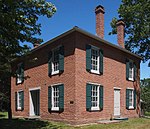I-35W & 98th Street station
Bus station stubsBus stations in MinnesotaMinnesota transportation stubs

I-35W & 98th Street is a bus rapid transit station on the Metro Orange Line at 98th Street adjacent to Interstate 35W in Bloomington, Minnesota. The station is integrated with the South Bloomington Transit Center, a transfer hub and park and ride facility opened in 2004. The transit center was as far south as Route 535, predecessor to the Orange Line, traveled, with no direct connection to the other side of the Minnesota River. The station opened December 4, 2021 with the rest of the Orange Line. The parcels surrounding the station are being planned for a mix of transit oriented development.
Excerpt from the Wikipedia article I-35W & 98th Street station (License: CC BY-SA 3.0, Authors, Images).I-35W & 98th Street station
West 99th Street,
Geographical coordinates (GPS) Address Nearby Places Show on map
Geographical coordinates (GPS)
| Latitude | Longitude |
|---|---|
| N 44.825005 ° | E -93.290632 ° |
Address
South Bloomington Transit Center
West 99th Street
55420
Minnesota, United States
Open on Google Maps




